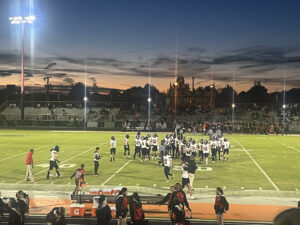You’re driving down Broad Street, probably not paying as much attention to the road as you should for whatever reason – children screaming in the back seat, singing along to a favorite song on the radio, thinking about plans for the evening – when you see a white flash in your rear-view mirror and find yourself inexplicably on the other end of the intersection you were approaching. You’ve just run a red light, and because of Falls Church City’s new red light photo enforcement, you’re in trouble. But what happens after that infraction? In an interview with the News-Press, Sgt. Pilar Uelmen of the Falls Church City Police Department explained the process which has some local drivers both confused and afraid.
This is the first article in a two-part series looking at Falls Church City’s use of cameras to enforce red light violations. The second part will appear in next week’s edition of the News-Press.
You’re driving down Broad Street, probably not paying as much attention to the road as you should for whatever reason – children screaming in the back seat, singing along to a favorite song on the radio, thinking about plans for the evening – when you see a white flash in your rear-view mirror and find yourself inexplicably on the other end of the intersection you were approaching.
You’ve just run a red light, and because of Falls Church City’s new red light photo enforcement, you’re in trouble.
But what happens after that infraction? In an interview with the News-Press, Sgt. Pilar Uelmen of the Falls Church City Police Department explained the process which has some local drivers both confused and afraid.
How It Works
As a car approaches two City intersections – at Annandale Road and West Broad Street and at Cherry Street and East Broad Street – cameras monitor the car’s velocity.
“The way that the system first targets a vehicle is it analyzes the velocity of the deceleration of the vehicle as it approaches,” Uelmen said. “If it predicts the vehicle is going to run a red light, it flags that for archiving.”
The camera then takes a photo of the car before the white line marking the place where cars should stop for the red light, or the stop bar. Though drivers may trigger the camera’s flash for the first photo, Uelmen says this isn’t a certain indicator that the driver will receive a citation.
“One flash means the first photo has been taken,” Uelmen said, meaning the system has predicted that the car will run the red light. “If the car comes to a lawful stop, the second flash does not occur. As a rule of thumb, if you see one flash, it’s probably OK. If you see two, somebody’s getting a ticket.”
That second flash is the camera taking another photo of the car, this time while the car is within the intersection or, if the car is driving too fast to be captured, after it has gone through the intersection.
The photos, as well as video from the violation, are cataloged for review by police officers.
“By Virginia state law, a sworn officer has to review the evidence of the violation. We have two officers now who are trained and registered with the system as users, myself and the services division commander here,” Uelmen said. “It doesn’t have to be just two, most jurisdictions have several. Hopefully two is all we’ll need. We don’t want drivers to be doing this all the time.”
While video and photos may be flagged because the system believes they contain evidence of a violation, an officer reviews that information and makes the final decision as to whether or not a citation will be issued.
“When I review the violations, I check very carefully,” Uelmen said, adding that she checks to make sure not only that the violation occurred but that the registration the system pulled up actually matches that vehicle, and that the citation is being issued to the registered owner of the vehicle. During this process, some vehicles – such as snow plows, or vehicles involved in a funeral procession, for example – are deemed as not in violation and not issued a citation.
“The only violations being issued are actual, bonafide violations,” Uelmen said.
The camera systems are provided by American Traffic Solutions, a company which provides devices for road safety and toll enforcement programs across the nation.
The Citation
If a car is deemed in violation, a notice is sent out to the owner of that car. The notice is a two-sided page with the City’s seal from the Falls Church City Police Department which includes the name and address of owner and a notice number. The notice also lists the date of the violation, the time it occurred, at what intersection it occurred, the issuing officer, the make and model of the car, and a line that specifies the $50 fine. Also included in the document is a pin number and a password-protected link that allows the car’s owner to go online and view the video of the violation.
Three photos are printed on the right side of the document. One is a close-up shot of the car’s license plate. The other two photos are the photos taken by the camera – first the shot of the car before the stop bar, then the shot of the car within or past the intersection.
Printed with the photos is information from when the images were taken. This include the R Time (how long the light was red when the car drove through the intersection), the phase (the color of the signal at the time the car drove through, in all cases, R for red), the amber length (adopting the terminology the Virginia Department of Transportation uses to describe a yellow light, the length of time the light at this intersection remains yellow), how fast the car was traveling, and which lane the offending car was traveling in (lanes being numbered from the median out to the curb starting with 1).
The bottom third of the document is a payment coupon, which directs those in violation to issue payment to the Falls Church City Treasurer’s Office. Payment must be issued within 30 days. If the fine isn’t paid, another notice is mailed asking for payment within 15 days.
“If payment is still not received, we refer those delinquent accounts to the City treasurer’s office, and at that point it becomes an issue for the treasurer,” Uelmen said.
The citation is issued to the registered owner of the car, because by state law, the registered owner of the vehicle is assumed to be the operator at the time of the violation.
However, there is hope for car owners who were not driving their car when it was recorded running a red light. On the form, there are instructions as to how to contest the citation in court, as well as how to submit an affidavit saying that the car’s owner was not driving the car when it ran the red light.
A form is available on the enforcement system’s website, violationinfo.com, that the car’s owner can print, fill out, and have notarized.
“Basically the way the law in Virginia is structured, it gives the driver and the owner of the vehicle every benefit of the doubt,” Uelmen said. “You do not have to identify who the driver of the vehicle was. All you have to do is swear that it was not you.”
She added that the car’s owner can, however, say who was driving the car and have the citation issued to that person, a method often employed by rental car companies.
The form also specifies that the driver will incur no points on his or her license because of the infraction, and Uelmen added that running the red light would not be reported to the driver’s insurance company or to the Department of Motor Vehicles.
See the second part of the story here.










